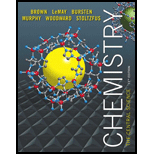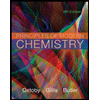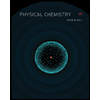
Chemistry: The Central Science (13th Edition)
13th Edition
ISBN: 9780321910417
Author: Theodore E. Brown, H. Eugene LeMay, Bruce E. Bursten, Catherine Murphy, Patrick Woodward, Matthew E. Stoltzfus
Publisher: PEARSON
expand_more
expand_more
format_list_bulleted
Concept explainers
Textbook Question
Chapter 7, Problem 20E
Why does the
Expert Solution & Answer
Want to see the full answer?
Check out a sample textbook solution
Students have asked these similar questions
Provide with detail, the concept of “Spin” in quantum entanglement, and provide a diagram to best visualize the concept.
Which orbital contains two planar nodes (where there is essentially a zero probability of electron density)?
In the experiment shown schematically below, a beam ofneutral atoms is passed through a magnetic field. Atoms thathave unpaired electrons are deflected in different directionsin the magnetic field depending on the value of the electronspin quantum number. In the experiment illustrated,we envision that a beam of hydrogen atoms splits into twobeams. (a) What is the significance of the observation that the single beam splits into two beams? (b) What do you thinkwould happen if the strength of the magnet were increased?(c) What do you think would happen if the beam of hydrogenatoms were replaced with a beam of helium atoms? Why?(d) The relevant experiment was first performed by OttoStern and Walter Gerlach in 1921. They used a beam of Agatoms in the experiment. By considering the electron configurationof a silver atom, explain why the single beam splitsinto two beams.
Chapter 7 Solutions
Chemistry: The Central Science (13th Edition)
Ch. 7.3 - Prob. 7.1.1PECh. 7.3 - Prob. 7.1.2PECh. 7.3 - Prob. 7.2.1PECh. 7.3 - Prob. 7.2.2PECh. 7.3 - Prob. 7.3.1PECh. 7.3 - Prob. 7.3.2PECh. 7.3 - Prob. 7.4.1PECh. 7.3 - Prob. 7.4.2PECh. 7.4 - Prob. 7.5.1PECh. 7.4 - Prob. 7.5.2PE
Ch. 7.4 - Prob. 7.6.1PECh. 7.4 - The atomic masses of hydrogen-2 (deuterium),...Ch. 7.4 - Prob. 7.7.1PECh. 7.4 - Prob. 7.7.2PECh. 7.6 - Prob. 7.8.1PECh. 7.6 - Prob. 7.8.2PECh. 7.6 - Prob. 7.9.1PECh. 7.6 - Prob. 7.9.2PECh. 7.7 - Prob. 7.10.1PECh. 7.7 - Prob. 7.10.2PECh. 7 - Prob. 1DECh. 7 - Prob. 1ECh. 7 - Prob. 2ECh. 7 - Prob. 3ECh. 7 - Prob. 4ECh. 7 - Prob. 5ECh. 7 - Prob. 6ECh. 7 - Prob. 7ECh. 7 - Prob. 8ECh. 7 - Prob. 9ECh. 7 - Prob. 10ECh. 7 - You might have expected that the elements would...Ch. 7 - Prob. 12ECh. 7 - (a) What is meant by the term effective nuclear...Ch. 7 - Prob. 14ECh. 7 - Prob. 15ECh. 7 - Prob. 16ECh. 7 - Prob. 17ECh. 7 - Prob. 18ECh. 7 - Prob. 19ECh. 7 - Why does the quantum mechanical description or...Ch. 7 - Prob. 21ECh. 7 - Prob. 22ECh. 7 - Prob. 23ECh. 7 - Prob. 24ECh. 7 - Prob. 25ECh. 7 - Prob. 26ECh. 7 - Prob. 27ECh. 7 - Prob. 28ECh. 7 - Prob. 29ECh. 7 - Prob. 30ECh. 7 - Prob. 31ECh. 7 - Prob. 32ECh. 7 - Prob. 33ECh. 7 - Prob. 34ECh. 7 - Prob. 35ECh. 7 - In the ionic compounds LiF, NaCl, KBr, and RbI,...Ch. 7 - Prob. 37ECh. 7 - Prob. 38ECh. 7 - Prob. 39ECh. 7 - Prob. 40ECh. 7 - Prob. 41ECh. 7 - Prob. 42ECh. 7 - Prob. 43ECh. 7 - Prob. 44ECh. 7 - Prob. 45ECh. 7 - Prob. 46ECh. 7 - Prob. 47ECh. 7 - Prob. 48ECh. 7 - Prob. 49ECh. 7 - Prob. 50ECh. 7 - 7.51 Although the electron affinity ofbromineis a...Ch. 7 - Prob. 52ECh. 7 - Prob. 53ECh. 7 - Prob. 54ECh. 7 - Prob. 55ECh. 7 - Prob. 56ECh. 7 - Prob. 57ECh. 7 - Prob. 58ECh. 7 - Prob. 59ECh. 7 - Prob. 60ECh. 7 - Prob. 61ECh. 7 - Prob. 62ECh. 7 - Prob. 63ECh. 7 - Prob. 64ECh. 7 - Prob. 65ECh. 7 - Why does xenon form stable compounds with...Ch. 7 - Prob. 67ECh. 7 - Prob. 68ECh. 7 - Prob. 69ECh. 7 - Prob. 70ECh. 7 - Prob. 71ECh. 7 - Prob. 72ECh. 7 - Prob. 73ECh. 7 - Prob. 74ECh. 7 - Prob. 75ECh. 7 - Prob. 76ECh. 7 - Prob. 77ECh. 7 - Prob. 78ECh. 7 - Prob. 79AECh. 7 - Prob. 80AECh. 7 - Prob. 81AECh. 7 - Prob. 82AECh. 7 - Prob. 83AECh. 7 - Prob. 84AECh. 7 - Prob. 85AECh. 7 - Prob. 86AECh. 7 - Prob. 87AECh. 7 - Prob. 88AECh. 7 - Prob. 89AECh. 7 - Prob. 90AECh. 7 - Prob. 91AECh. 7 - Write a chemical formula for each compound or ion,...Ch. 7 - Prob. 93AECh. 7 - Prob. 94AECh. 7 - Prob. 95AECh. 7 - Prob. 96AECh. 7 - Prob. 97AECh. 7 - Prob. 98AECh. 7 - Prob. 99AECh. 7 - Prob. 100AECh. 7 - Prob. 101AECh. 7 - Prob. 102AECh. 7 - Prob. 103AECh. 7 - Prob. 104AECh. 7 - Prob. 105AECh. 7 - Prob. 106AECh. 7 - Prob. 107AECh. 7 - Prob. 108AECh. 7 - Prob. 109AECh. 7 - Prob. 110IECh. 7 - Prob. 111IECh. 7 - Prob. 112IECh. 7 - Prob. 113IECh. 7 - Prob. 114IECh. 7 - Prob. 115IE
Knowledge Booster
Learn more about
Need a deep-dive on the concept behind this application? Look no further. Learn more about this topic, chemistry and related others by exploring similar questions and additional content below.Similar questions
- Photoelectron spectroscopy studies have determined the orbital energies for fluorine atoms to be 1s689eV2s34eV2p12eV Estimate the value of Zeff for F in each of these orbitals.arrow_forwardChromium(IV) oxide is used in making magnetic recording tapes because it is paramagnetic. It can be described as a solid made up of Cr4+ and O2 . Give the electron configuration of Cr4+ in CrO2 , and determine the number of unpaired electrons on each chromium ion.arrow_forwardBoth the electron affinity and the ionization energy of chlorine are higher than the corresponding quantities for sulfur. Explain why in terms of the electronic structure of the atoms.arrow_forward
- Is the spin orbital 1s for the H atom still spherically symmetric? Explain your answer.arrow_forwardThe photoelectric effect is used today to make light-sensitive detectors; when light hits a sample of metal in a sealed compartment, a current of electrons may flow if the light has the proper wavelength. Cesium is a desirable component for such detectors. Why?arrow_forwardWhy do valence shell s and p orbitals generally become further apart in energy on descending a group in the periodic table?arrow_forward
- Bromine is used in the manufacture of disinfectant products, it has a very strong oxidizing character, due to the great electronic affinity it presents. Based on therefore, what will be the electron affinity in kJ/mol of bromine from the following equations?. Explain the development.arrow_forwardWhere in the figure is the region ofhighest electron density?arrow_forwardwhich d-orbital has maximum electron density in xy-plane?arrow_forward
- The ground state electron configuration of As is?arrow_forwardDescribe and account for the variation of first ionizationenergies along Period 2 of the periodic table . Would you expect the same variation in Period 3?arrow_forwardThe energy required to dissociate the O2 molecule to oxygen atoms is 495 kJ/mol. If the dissociation of O2 molecule were accomplished by the absorption of a single photon whose energy was exactly the quantity required, what would be its wavelength in nm? Must show all formulas and calculations used for steps taken to calculate the wavelengtharrow_forward
arrow_back_ios
SEE MORE QUESTIONS
arrow_forward_ios
Recommended textbooks for you
 Principles of Modern ChemistryChemistryISBN:9781305079113Author:David W. Oxtoby, H. Pat Gillis, Laurie J. ButlerPublisher:Cengage Learning
Principles of Modern ChemistryChemistryISBN:9781305079113Author:David W. Oxtoby, H. Pat Gillis, Laurie J. ButlerPublisher:Cengage Learning Chemistry: The Molecular ScienceChemistryISBN:9781285199047Author:John W. Moore, Conrad L. StanitskiPublisher:Cengage Learning
Chemistry: The Molecular ScienceChemistryISBN:9781285199047Author:John W. Moore, Conrad L. StanitskiPublisher:Cengage Learning Physical ChemistryChemistryISBN:9781133958437Author:Ball, David W. (david Warren), BAER, TomasPublisher:Wadsworth Cengage Learning,
Physical ChemistryChemistryISBN:9781133958437Author:Ball, David W. (david Warren), BAER, TomasPublisher:Wadsworth Cengage Learning, Chemistry: Principles and PracticeChemistryISBN:9780534420123Author:Daniel L. Reger, Scott R. Goode, David W. Ball, Edward MercerPublisher:Cengage Learning
Chemistry: Principles and PracticeChemistryISBN:9780534420123Author:Daniel L. Reger, Scott R. Goode, David W. Ball, Edward MercerPublisher:Cengage Learning

Principles of Modern Chemistry
Chemistry
ISBN:9781305079113
Author:David W. Oxtoby, H. Pat Gillis, Laurie J. Butler
Publisher:Cengage Learning

Chemistry: The Molecular Science
Chemistry
ISBN:9781285199047
Author:John W. Moore, Conrad L. Stanitski
Publisher:Cengage Learning

Physical Chemistry
Chemistry
ISBN:9781133958437
Author:Ball, David W. (david Warren), BAER, Tomas
Publisher:Wadsworth Cengage Learning,

Chemistry: Principles and Practice
Chemistry
ISBN:9780534420123
Author:Daniel L. Reger, Scott R. Goode, David W. Ball, Edward Mercer
Publisher:Cengage Learning
Quantum Mechanics - Part 1: Crash Course Physics #43; Author: CrashCourse;https://www.youtube.com/watch?v=7kb1VT0J3DE;License: Standard YouTube License, CC-BY